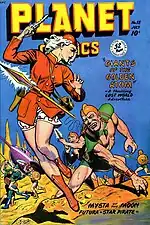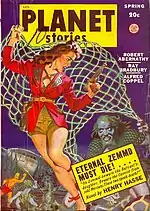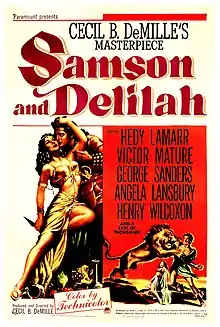Swipe (comics)
Swipe is a comics term for the intentional copying of a cover, panel, or page from an earlier comic book or graphic novel without crediting the original artist.
Artists Jack Kirby, Neal Adams, Hergé, and Jim Lee are common targets of swipes, though even those artists may not be above reproach; Kirby was known to have swiped from Hal Foster early in his career.[1] Similarly, many Golden Age artists kept "swipe files" of material to be copied as needed.[2] Certain contemporary artists have become notorious for their swiping, including Rich Buckler (who favors Neal Adams and Jack Kirby), Rob Liefeld (many artists), Keith Giffen (José Antonio Muñoz), and Roger Cruz (Jim Lee and Joe Madureira).
There is a long tradition in comics of using fine art as "inspiration" as well. Most observers do not consider this as objectionable as swiping from another cartoonist's work. Examples include Art Spiegelman swiping an image of the Russian artist M. Mazruho's in Maus,[3] Eddie Campbell swiping Diego Velázquez,[4] and Jill Thompson swiping the work of Arthur Rackham.[5]
Cartoonists have also swiped images from mass media and commercial art. Examples include Batman creator Bob Kane repeatedly swiping from early 20th-century illustrator Henry Vallely,[6][7] Greg Land repeatedly swiping pornography as well as many popular comic book artists,[8][9] 2000 AD artist Mick Austin swiping an image of Toni Shilleto's from Mayfair: Entertainment for Men,[10] Jon J. Muth swiping a 1940s photograph,[11] and David Chelsea swiping from Spanish pornography.[12] Sometimes the swiping happens "in reverse", as in the example of an illustration from Organic Gardening magazine swiping the iconic Kirby cover for Fantastic Four #1.[13]
Swiping brings to mind the amusing conundrum of whether an artist can swipe from himself. One example is two almost-identical Peanuts strips by Charles Schulz done almost ten years apart.[14] Another comic strip-related ethics question was invoked by latter-day Nancy artists Guy & Brad Gilchrist swiping Nancy creator Ernie Bushmiller.[15]
"Cloning"
Though not technically swiping, some artists have made a career "cloning" other artists. Phil Jimenez has been quite open about his work being modeled on George Pérez's,[16] though he has never been accused of directly swiping a Pérez drawing. Bryan Hitch started off as an Alan Davis "clone".[17] Bill Sienkiewicz's early work was blatantly derivative of Neal Adams,[18] as was Tom Grindberg's,[17] Michael Netzer (Nasser)'s, and Mike Grell's. Industry veteran Dick Giordano maintained that cloning is not only acceptable, but actually preferable, when an artist fills in for a regular artist on a title.[19]
Appropriation
Pop artist Roy Lichtenstein made a splash in the 1960s with his "appropriations" based on the work of Kirby, Russ Heath, Tony Abruzzo, Irv Novick, John Romita Sr., and Jerry Grandenetti, who rarely received any credit. Jack Cowart, executive director of the Lichtenstein Foundation, contests the notion that Lichtenstein was a copyist, saying: "Roy's work was a wonderment of the graphic formulae and the codification of sentiment that had been worked out by others. The panels were changed in scale, color, treatment, and in their implications. There is no exact copy."[20] Comics industry figures don't have such a sanguine attitude about Lichtenstein's swipes.[2]
Similarly, Canadian artist Kevin Mutch once drew an entire comic book entirely based on swipes. Mutch's 1993 comic Captain Adam was a "narrative collage" of images and texts from over fifty separate Silver Age and Bronze Age comics, randomly put together to form an original story.
Pastiches
Comics pastiches are blatant uses of swipes, cloning, and appropriation, usually using the same characters as the original source. French-Canadian cartoonist Yves Rodier is known for his many Adventures of Tintin pastiches, as is the anonymously written comic book The Adventures of Tintin: Breaking Free. In his Masterpiece Comics series, American cartoonist R. Sikoryak cleverly mixes exact cloning of famous cartoonists' styles with classic literary texts, creating unique comics "mash-ups". Alan Moore and Rick Veitch's 1963 series is another example of pastiche in comics form, as are the many take-offs of the Charles Atlas ads found in old comic books.
Homages
In comics, it is understood that the difference between a swipe and an "homage" is generally whether the source is directly acknowledged — as opposed to being exposed by a third party. Throughout the history of the medium, artists have engaged in homages – most often of well-known cover images like Action Comics No. 1, Detective Comics No. 27, Amazing Fantasy No. 15, and Fantastic Four No. 1. (John Byrne is particularly fond of doing homages to the latter, having produced at least seven versions to date.)[21] Some observers find homages as objectionable as swiping.[2]
Swiping watchdogs
From 1991 until at least 1997, the industry magazine The Comics Journal kept a "Swipe File" which documented perceived swipes in the comics field, a tradition that continues on the TCJ website.
Artists accused of swiping
| Alleged Swiper | Source | Notes |
|---|---|---|
| Michael Allred | David Chelsea[22] | Allred denied the charges.[23] |
| Chester Brown | Joe Orlando[24] | |
| Rich Buckler | Neal Adams[25] | Buckler has a dubious reputation as one of comics' top "swipe" artists,[26] with his early work in particular filled with "homages" to artists like Jack Kirby, John Buscema, and Neal Adams. After being publicly accused of the practice by The Comics Journal in the early 1980s,[27] Buckler denied the charges[28] and sued the magazine for libel;[29] he later dropped the suit.[30] |
| Jack Kirby[31][32] | ||
| Charles Burns | Hergé[33] | |
| Denys Cowan | Gil Kane[17] | |
| Glyn Dillon | Jaime Hernandez[34] | |
| Steve Ditko | Will Eisner[35] | |
| Ron Frenz | Jack Kirby[36] | |
| Keith Giffen | José Antonio Muñoz[37][38][39] | Giffen has acknowledged Muñoz's influence, and in 2000 referred to the controversy this way:
In 1986 Giffen was one of the most popular comic book artists in the industry. The ensuing swiping controversy hurt Giffen's reputation.[2][41] |
| Bob Kane | Alex Raymond[42] | The classic Batman pose on the cover of Detective Comics No. 27 (the first appearance of Batman) is swiped from a 1937 Alex Raymond drawing of Flash Gordon.[42] |
| Gil Kane | Jack Kirby[31][43] | |
| Jack Kirby | Hal Foster[1] | |
| Peter Kuper | Rius[44] | |
| Ralph Steadman[45] | ||
| Alan Kupperberg | Gil Kane[31] | |
| Roy Lichtenstein | Irv Novick, Bruno Premiani, Jerry Grandenetti, Russ Heath[46][47] | |
| Rob Liefeld | Brent Anderson[48] | |
| John Byrne[2][49] | ||
| Frank Miller[2][50] | ||
| George Pérez[2] | ||
| Ron Wilson[48] | ||
| David W. Mack | Adam Hughes[51] | Mack admitted the Hughes swipes online:
|
| Todd McFarlane | Otomo Katsuhiro[53] | |
| Joe Phillips | Barry Windsor-Smith[54] | |
| Joe Simon | John Prentice[55][56] | The stories "Man in the House" from Young Romance #101 (August-September 1959) and "Take Me Back" from All for Love #16 (October-November 1959), both credited to Joe Simon, are swipes of entire Prentice-drawn stories "The Irresistible Bum" from Young Romance #72 (August 1954) and "One More Time" from First Love Illustrated #41 (June 1954), respectively.[55][56] |
| Andi Watson | Mike Allred[57] |
See also
Notes
- O'Brien, Richard. "Golden Age Gleanings", The Nostalgia Journal No. 8 (February 1975), p. 20.
- Best, Daniel. "A Rose By Any Other Name", 20th Century Danny Boy (June 26, 2006).
- "Swipe File", The Comics Journal No. 141 (April 1991), p. 117.
- "Swipe File", The Comics Journal No. 155 (January 1993), p. 8.
- "Swipe File", The Comics Journal No. 175 (March 1995), pp. 4–5.
- "Gang Busters! (Secret Origins of Batman Part 1)", The Vallely Archives (May 25, 2006).
- Kimball, Kirk. "Secret Origins of The Batman, Chapter 3: The Haunting of Robert Kane!" Dial B for Blog (Sept.).
- "Reinventing the pencil: 21 artists who changed mainstream comics (for better or worse)". Onion AV Club. July 20, 2009. Retrieved November 25, 2009.
- "Marvel artist Greg Land accused of plagiarism in new 'Aliens' comic". The Daily Dot. September 2, 2020.
- "Swipe File", The Comics Journal No. 143 (Apr. 1991), p. 59: Austin's 2000 AD No. 713 (January 12, 1991) and Shilleto's art from Mayfair (December 1989).
- "Swipe File", The Comics Journal No. 171 (September 1994), p. 5.
- "Swipe File", The Comics Journal No. 176 (Apr. 1995), pp. 6–8.
- "Swipe File", The Comics Journal No. 158 (Apr. 1993), p. 9: Organic Gardening, v. 40, No. 4 (Apr. 1993) vs. Fantastic Four No. 1 (1961).
- "Swipe File", The Comics Journal No. 184 (February 1996), p. 5: strips of June 11, 1987, and January 20, 1996.
- "Swipe File", The Comics Journal No. 190 (September 1996), pp. 8–9.
- Simmons, Scott. "Phil Jimenez Talks About The Invisibles", Archived August 16, 2009, at the Wayback Machine Heroes & Dragons (Feb. 1997).
- Larsen, Erik. "One Fan's Opinion" #17, Comic Book Resources (December 1, 2005).
- Thomas, Michael. "Bill Sienkiewicz Interview," Comic Book Resources (July 17, 2001): "Studying Neal's work, ... I became obsessed ... and became fixated on it. It was like my intention was to be Neal. ... Neal has been nothing but wonderful and supportive from then till now. I don't think he sees me as a clone anymore."
- "Reinventing the Rules," in Eury, Michael. Dick Giordano: Changing Comics, One Day at a Time TwoMorrows Publishing (November 5, 2003), p. 136: ISBN 1-893905-27-6.
- Beam, Alex (October 18, 2006). "Lichtenstein: creator or copycat?" (Web). Editorial. Boston.com. Retrieved July 16, 2007.
- Amazing Heroes No. 1 (June 1981), What If No. 36 (December 1982), Fantastic Four No. 264 (March 1984), Marvel Age No. 14 (May 1984), Avengers West Coast No. 54 (January 1990), Danger Unlimited No. 4 (May 1994), and X-Men: The Hidden Years No. 20 (July 2001)
- "Swipe File", The Comics Journal No. 168 (May 1994), p. 5.
- Allred, Michael. "Blood & Thunder: Not Guilty", The Comics Journal #169 (July 1994), p. 12.
- "Swipe File", The Comics Journal No. 166 (February 1994), p. 5.
- Gillis, Peter B. Letter about Rich Buckler swipes, The Comics Journal No. 45 (March 1979), pp. 22.
- Cooke, Jon B. "Dan Adkins' Strange Tales: The Artist on his Visits to the World of Wood and the House of Ideas", Comic Book Artist Collection (TwoMorrows Publishing, 2005), p. 42.
- "Plagiarism: Rich Buckler Signs his Name to Jack Kirby's Work", The Comics Journal #83 (August 1983), pp. 33–35.
- "Rich Buckler Answers His Critics", The Comics Journal #86 (November 1983), pp. 28–31.
- "Rich Buckler Sues Comics Journal and two of its Writers for Libel", The Comics Journal #88 (January 1984), p. 13.
- "Buckler Drops Comics Journal Libel Suit", The Comics Journal #93 (September 1984), pp. 11–12.
- Larsen, Erik. "One Fan's Opinion" #15, Comic Book Resources (November 17, 2005).
- O'Neill, Patrick Daniel. "Career Moves" (interview with George Pérez), Wizard Magazine #35 (July 1994) Archived September 7, 2009, at the Wayback Machine:
Question: What did you do as Buckler's assistant?
Pérez: Basically, I helped him with layout. Or I'd go through his swipe file — batches of comics — looking for suitable swipes for the story he was doing. Since at the time he was doing Thor and Fantastic Four, that meant lots of Jack Kirby books. - "Swipe File", The Comics Journal No. 178 (July 1995), p. 9.
- "Blood & Thunder: Swipe File", The Comics Journal #161 (Aug. 1993), p. 6.
- "Ditko's Eisner Swipe", The Comics Journal No. 43 (December 1978), pp. 23–24.
- Boyd, Robert. "Swipe File", The Comics Journal No. 140 (February 1991), p. 28.
- Burbey, Mark. "The Trouble With Keith Giffen", The Comics Journal No. 105 (February 1986), pp. 9–14.
- "The Official Keith Giffen Swipe List", The Comics Journal No. 105 (February 1986), p. 15.
- "More Giffen Swipes in Taboo", The Comics Journal No. 125 (October 1988), pp. 20–21.
- Keith Giffen interviewed by Jon B. Cooke, Jack Kirby Collector No. 29 (Aug. 2000).
- Jozic, Mike. "Meanwhile Interviews Keith Giffen" Part 3," Archived April 3, 2005, at the Wayback Machine Meanwhile... The Web's Snappiest E'Zine (1999).
- Schumer, Arlen. Comic Book Artist/Alter-Ego Vol.1 No. 5 (1999).
- "Swipe File", The Comics Journal No. 142 (June 1991), p. 117.
- "Swipe File", The Comics Journal No. 154 (November 1992), p. 118.
- "Swipe File", The Comics Journal No. 192 (December 1996), p. 4.
- Paul Gravett: The Principality of Lichtenstein: From 'WHAAM!' to 'WHAAT?', 17 March 2013. Accessed on 6 September 2019.
- Childs, Brian (February 2, 2011). "Deconstructing Lichtenstein: Source Comics Revealed and Credited". Comics Alliance. Archived from the original on January 12, 2013. Retrieved June 23, 2013.
- "Swipe File", The Comics Journal No. 170 (August. 1994), p. 5.
- Leifeld's New Mutants No. 93 (September 1990), p. 5, vs. Byrne's Fantastic Four No. 247 (October 1982), p. 21
- Leifeld's New Mutants No. 100 (Marvel Comics, April 1991) vs. Miller's Ronin No. 1 (DC Comics, 1983).
- Mack's New Avengers No. 39 (Marvel Comics, May 2008) vs. Hughes' earlier work.
- Mack quoted in "To Swipe or Not to Swipe", Comic Geek Speak website (February 26, 2008).
- "Swipe File", The Comics Journal No. 146 (November 1991), p. 14.
- "Swipe File", The Comics Journal No. 167 (April 1994), pp. 4–6.
- ""Man in the House", Young Romance #101 (August-September 1959)". Grand Comics Database. Grand Comics Database. Retrieved September 27, 2022.
- ""Take Me Back", All for Love #16 (October-November 1959)". Grand Comics Database. Grand Comics Database. Retrieved September 27, 2022.
- "Swipe File", The Comics Journal No. 198 (August 1997), p. 4.
References
- Erik Larsen's "One Fan's Opinion" columns at Comic Book Resources on swiping: #15 (November 17, 2005) and #17 (December 1, 2005)
- Best, Daniel. "A Rose by Any Other Name," 20th Century Danny Boy (June 26, 2006) — on the distinction between swipes and homages



